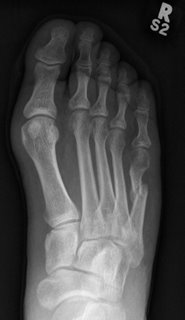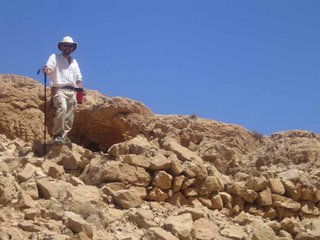This is the weblog of the Canadian archaeological project at Deir Mar Musa al-Habashi, Syria. This is intended to be an informal and personal record of the team's activities. For a profesional presentation of the project, see the web-site.
Saturday, September 09, 2006
Tuesday, September 05, 2006
Syria
The field aside, let's talk about how wonderful the people of this country are!
We've been back for a week now, and I can't stop thinking of this place. I am so grateful for my experiences and memories of mar musa and of Syria. I am so thankful to Rob for having taken our team out to contribute and to experience this unforgettable place. Really such a truly unique and genuine place to be. I think that Mar Musa really gave me the perspective that I needed in terms of what matters in life.
It's strange. I’ve been in many rugged field experiences many times before. I’ve got to say, in comparison to previous experiences, this one was quite cushy. Just look at the pics to see how picturesque it was... and just look at Deir Mar Musa's mandate and understand that the people living here truly adhere to their commitment to hospitality. I am tearful thinking about how wonderful they are. I will never forget the time that I’ve spent here and I hope that the work that I managed to do will contribute to something good, to the goals and dreams of its residents and that I can contribute again, somehow, one day.
Research and museums aside, being home and safe and healthy now, I need to admit that my time abroad was one of the most difficult times I’ve ever experienced.. This due to health issues and not because of the people or of their surroundings or of the work (all of that was amazing), unfortunately, I really had never been sicker in my life. A chest infection gone horribly wrong can be a very scary thing to face in foreign lands- especially when one does not speak the language!
But this challenge, I think, is what really helped me understand how wonderful this country really is. I will forever remember the true kindness and true caring of strangers (and of Rob, Francesca, Jovanna and Tiago too) that I would have never experienced in Canada under the same circumstances. Never in Canada would I expect a stranger to race me around a city to find the best/quickest health care, to offer to pay for my medication (despite the steep price), for a woman who speaks no English or French to take me in, feed me, care for me, and to put my mind at ease while I try to recover. Never would I expect hoteliers in Canada to give me a room for free to rest, because it was obvious that I was completely exhausted. I have never felt more safe, secure and looked after in a time of need (okay okay, I did wish my mum was around a little, but that's cause she's my mum).
I think that I will spend the rest of my life trying to abide by these notions of hospitality and caring- I will forever remember the kindness.
feelin' the lovin'
and so very very grateful!
shukran,
Joelle.
We've been back for a week now, and I can't stop thinking of this place. I am so grateful for my experiences and memories of mar musa and of Syria. I am so thankful to Rob for having taken our team out to contribute and to experience this unforgettable place. Really such a truly unique and genuine place to be. I think that Mar Musa really gave me the perspective that I needed in terms of what matters in life.
It's strange. I’ve been in many rugged field experiences many times before. I’ve got to say, in comparison to previous experiences, this one was quite cushy. Just look at the pics to see how picturesque it was... and just look at Deir Mar Musa's mandate and understand that the people living here truly adhere to their commitment to hospitality. I am tearful thinking about how wonderful they are. I will never forget the time that I’ve spent here and I hope that the work that I managed to do will contribute to something good, to the goals and dreams of its residents and that I can contribute again, somehow, one day.
Research and museums aside, being home and safe and healthy now, I need to admit that my time abroad was one of the most difficult times I’ve ever experienced.. This due to health issues and not because of the people or of their surroundings or of the work (all of that was amazing), unfortunately, I really had never been sicker in my life. A chest infection gone horribly wrong can be a very scary thing to face in foreign lands- especially when one does not speak the language!
But this challenge, I think, is what really helped me understand how wonderful this country really is. I will forever remember the true kindness and true caring of strangers (and of Rob, Francesca, Jovanna and Tiago too) that I would have never experienced in Canada under the same circumstances. Never in Canada would I expect a stranger to race me around a city to find the best/quickest health care, to offer to pay for my medication (despite the steep price), for a woman who speaks no English or French to take me in, feed me, care for me, and to put my mind at ease while I try to recover. Never would I expect hoteliers in Canada to give me a room for free to rest, because it was obvious that I was completely exhausted. I have never felt more safe, secure and looked after in a time of need (okay okay, I did wish my mum was around a little, but that's cause she's my mum).
I think that I will spend the rest of my life trying to abide by these notions of hospitality and caring- I will forever remember the kindness.
feelin' the lovin'
and so very very grateful!
shukran,
Joelle.
Monday, August 28, 2006
The Real Story
We have now returned to Toronto!
So! A number of the team have experience of being away from home - I've been going to the field for many years, as has Joelle, and Francesca had her year-long stint in South Africa. One thing we all agreed about was communications from the field to our loved ones: short, to the point, and always positive. Since e-mail communication has been very difficult, this has been easy to maintain, except perhaps for when we hit the internet cafe in Aleppo! But they always remained positive. It seems that the team philosophy, as is that of any experienced field person to my knowledge, is that the objective is not to make your loved ones worry. If you are sick, or having deep thoughts about a relationship (including those with parents!), you keep it to yourself. The philosophy is just to come home to them, and sort it out from there. If they get upset that they were never told about the race to the hospital, you just shrug, and ask them why they thought it would help the situation if you were knowing they were immersed in futile worrying while you were struggling with, say, a chest infection. We also didn't tell people about our travels much, or, more specifically, how close those travels brought us to the Lebanese border. It had been my intention not to take the team to places like Saidnaya (within sight of Ba'albek), or Qal'at al-Husn (Crac de Chevalier - this would mean traveling along the strategic Homs pass about 10 km from northern Lebanon). However, after we arrived in Syria, and the team felt so incredibly comfortable with the welcome afforded by the Syrian people, and the security they felt not just in the monastery but anywhere in Syria, it was agreed that we would go to these places. But our loved ones did not feel that security like we did, so they would have only worried if they knew.
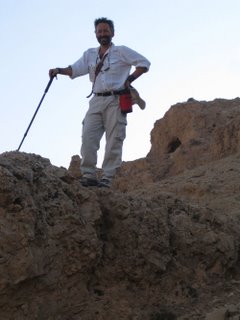
My problem was my foot. The occasional picture you may have seen of me with a walking staff was not because I thought that my leadership image might be helped by it (whether trying to seem more like Moses or Gandalf being a mute point). The fact is that I had broken my foot (nasty break of the 4th metatarsal) and had seriously twisted my ankle a couple of months before leaving, and the cast had only come off two weeks before leaving for Syria, after being in it for over 6 weeks. Needless to say the bone physician at the hospital thought the idea of mountain climbing in Syria with a broken foot to be fundamentally absurd, which is really not the sort of thing to say to me if you don't want me to do something. "Absurd" is the sort of term that gains my positive attention as quickly as terms like "chocolate" or "Australian Shiraz". The foot actually created quite a few problems. It was particularly cranky in the morning, which made the 5:30 am starts I had planned an impossibility (much to everyone's deep regret, I'm sure); and made all the climbing a lot more worrying and dangerous. The tale of the walk by moonlight may have been given a little extra zest if I had recounted how many times my walking staff, or my massive hiking boots, had saved my life that night, but I really didn't want anyone to worry! Towards the end, though, I started taking more risks - hence the "Over the Top" posting!!
But in the end we all survived, got a lot done, and then returned in one piece to the loved ones that we had said we would return to.
Robert
So! A number of the team have experience of being away from home - I've been going to the field for many years, as has Joelle, and Francesca had her year-long stint in South Africa. One thing we all agreed about was communications from the field to our loved ones: short, to the point, and always positive. Since e-mail communication has been very difficult, this has been easy to maintain, except perhaps for when we hit the internet cafe in Aleppo! But they always remained positive. It seems that the team philosophy, as is that of any experienced field person to my knowledge, is that the objective is not to make your loved ones worry. If you are sick, or having deep thoughts about a relationship (including those with parents!), you keep it to yourself. The philosophy is just to come home to them, and sort it out from there. If they get upset that they were never told about the race to the hospital, you just shrug, and ask them why they thought it would help the situation if you were knowing they were immersed in futile worrying while you were struggling with, say, a chest infection. We also didn't tell people about our travels much, or, more specifically, how close those travels brought us to the Lebanese border. It had been my intention not to take the team to places like Saidnaya (within sight of Ba'albek), or Qal'at al-Husn (Crac de Chevalier - this would mean traveling along the strategic Homs pass about 10 km from northern Lebanon). However, after we arrived in Syria, and the team felt so incredibly comfortable with the welcome afforded by the Syrian people, and the security they felt not just in the monastery but anywhere in Syria, it was agreed that we would go to these places. But our loved ones did not feel that security like we did, so they would have only worried if they knew.

My problem was my foot. The occasional picture you may have seen of me with a walking staff was not because I thought that my leadership image might be helped by it (whether trying to seem more like Moses or Gandalf being a mute point). The fact is that I had broken my foot (nasty break of the 4th metatarsal) and had seriously twisted my ankle a couple of months before leaving, and the cast had only come off two weeks before leaving for Syria, after being in it for over 6 weeks. Needless to say the bone physician at the hospital thought the idea of mountain climbing in Syria with a broken foot to be fundamentally absurd, which is really not the sort of thing to say to me if you don't want me to do something. "Absurd" is the sort of term that gains my positive attention as quickly as terms like "chocolate" or "Australian Shiraz". The foot actually created quite a few problems. It was particularly cranky in the morning, which made the 5:30 am starts I had planned an impossibility (much to everyone's deep regret, I'm sure); and made all the climbing a lot more worrying and dangerous. The tale of the walk by moonlight may have been given a little extra zest if I had recounted how many times my walking staff, or my massive hiking boots, had saved my life that night, but I really didn't want anyone to worry! Towards the end, though, I started taking more risks - hence the "Over the Top" posting!!
But in the end we all survived, got a lot done, and then returned in one piece to the loved ones that we had said we would return to.
Robert
Thursday, August 24, 2006
Clouds
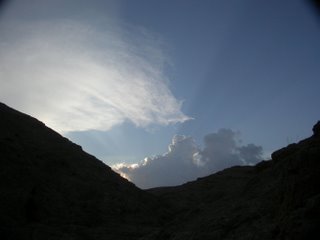
This is a nice picture. I can't remember seeing so many clouds at Deir Mar Musa before. Joelle and I were out recording caves, and sat down to discuss the archaeological project strategy in the future seasons as the Sun went down (this was 2 minutes walk from the monastery, not 2 hours away as Francesca and I were with Jens on the night of the moonlight walk!). Judging by the following picture of Joelle, I wonder if she thought that we were about to be rained upon? We weren't, but it was very pretty.
Robert
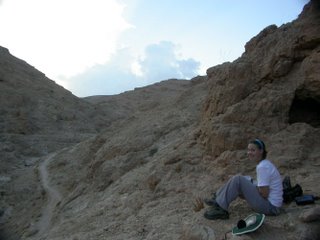
Wednesday, August 23, 2006
Caving
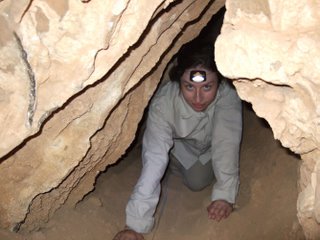
You see, here's the thing. I like rocks. Like to study them, stand on them, break them into smaller bits, work them into things, put them on top of each other to build walls - and I love the things other people have done with rocks. I just don't like going IN to them. Of course nice big open caves is fine, but squeezing into little squiggly holes, is not my thing. Probably has something to do with that tunnel I dug when I was a kid, which collapsed on me, dumping not only a lot of earth but what seemed to be an entire nest of earwigs on my head. So after Tiago and Francesca had explored this cave that had been turned into a cistern, and then Francesca wanted to take Jovanna down it too, I gave them a tape measure and told them to record it! Since it was a cistern I'd like to know its capacity. I may go down it one day, but then, I may not. Unlikely, probably.
Robert
Over the Side
 |
| Did I mention that I'm not keen on heights? |
One of the problems with the archaeological finds at the monastery is that I have always suspected that most of the things the previous residents didn't want was thrown over the patio into the deep ravine below, where it would have all been washed away in the seasonal floods. However, peering over from the t op, it looked to me as though there was *dirt* on the ledges below the monastery. This may contain some of the archaeological remains I was looking for.
The climbers having verified that there was a lot of dirt on the rock face below the monastery, I thought I'd better take a look. And there was dirt! I'll have to come back and dig it up another day, though!
 |
| Again with my "I am completely at ease" pose. Here I am at the bottom of the monastery building and Tiago is standing on one of the debris-strewn ledges. |
 |
| A bit further down, and still appreciating the ledges. Still a long way to go, though! An added bonus was near the bottom we discovered another hermit's cave, not high up but hidden from below. |
Robert
Tuesday, August 22, 2006
Sunday, August 20, 2006
Aleppo communications

As I have said before, communications is a bother for us at the monastery. E-mail is a trial with only one line out (for telephone, internet and fax) and that used rather a lot, and the dial-up incredibly slow when we do get it; and also our cell-phones don't work at the monastery! Now, for some people, this may sound attractive, but when you have loved ones at home that would like to hear from you, then it is a bit of a pain. It's no point you telling them that you are very busy, and that you don't miss them much because they don't belong in that context and so you can't miss them if they don't belong there - they don't want to hear that sort of thing. They want to hear that you love them and miss them, that everything's fine with you (no matter how close to death you actually are), and that you look forward to coming home to them (even if you actually want to stay out there forever). Now, one person I do like to talk to is my ten-year old daughter, and so when I can get away from the monastery when she can get my call, I like to call her, and here I am calling from the citadel of Aleppo. Later that night we had the luxury of an internet cafe!! A computer each, with a fast link!! It was heaven! Of course I'd rather have been at the Baron drinking Syrian beer, but when people gotta e-mail their loved ones, it takes precedence.
Robert
Aleppo
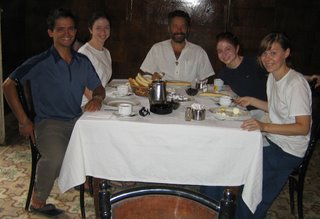
Since this year my team are all people with jobs that are actually using their holidays to be here, I've been giving them two days a week off to see some of Syria. This week's two days off was spent in Aleppo, and then spending a day traveling back. When in Aleppo, the team stay at The Baron Hotel. This is possibly the most famous hotel in Syria, where T. E. Lawrence (as in "of Arabia"), and Max Mallowan (and his wife Agatha Christie) stayed in their day. There is something of a legend in the discipline that you are not truly a Syrian archaeologist until you have stayed at the Baron. This is actually a credential I obtained on my first night in Syria in 1998! It was on my way to my first season with the excavations of the citadel at Aleppo. I had taken the bus directly from the Damascus airport, then got a taxi to the citadel, arriving at about midnight. It being a redoubtable fortress of some presence, I thought it best not to assail it, but to find a nice hotel and come back in the morning. I stayed up even later after arriving at the hotel, drinking in the hotel bar with two very nice Egyptians, and probably the ghosts of Lawrence and Mallowan! In 1998 the hotel was not quite as nice as it is now, as all the bathroom fixtures, and, I suspect, the beds, dated back to the days of Lawrence. The following morning, I went down to the breakfast room, and was struck by the size of the sideboards! I could imagine the massive spreads of English breakfasts that probably adorned these edifices in the old days, and I sat down earnestly hoping that the tradition continued! Then some chap came along and put a hard-boiled egg on my plate. Although admittedly disappointed, I ate it with a crusty bun and a cup of coffee, then walked to the citadel to start my career in Syrian archaeology.
The bathrooms are all mod-cons now, with air-conditioning in the rooms and a much more satisfying breakfast, while the hotel offers a history and atmosphere that no other in Syria can match. After our satisfying breakfast (see pic, above) I guided the team through the suq in a manner markedly reminiscent of someone trying to herd cats, until we came to the citadel.
Robert
Friday, August 18, 2006
Committee Meeting of the Protected Area of Wadi Mar Musa al-Habashi

16 August, 2006
Today, Robert and I made a presentation to the committee in charge of planning and executing the protected area of the Wadi Mar Musa al-Habashi. We prepared a lovely power point presentation for them and made our way into Nabek with Father Paolo (who is on the committee)…in the new community van I might add which was exciting in itself… and Francesca, who just wanted to come along. On our way to the meeting, we stopped for tea (chai) with Abu Adib, and then stopped by the bakery for some breakfast (yum). When we arrived at the meeting, we realized it was actually in the Mayor’s office! We sat with 10 other people discussing the state of the national park, the visitor centre, and its situation in terms of potential tourism and funding. It was very interesting. I recognized enough Arabic to know that Robert was introduced as a Doctor of Archaeology, I was introduced as a Master of Museums, and Francesca was introduced as my twin (“tom”…pronounced “tome”). Very nice.
Once introductions were finished, it was time for the presentation. Unfortunately, that coincided exactly with the time the power went off….every day power from Syria is sent to Lebanon for a period of time which changes by day and place. Well, fortunately the computer had batteries, so everyone crowded around while we made the presentation. The battery held until just before the last 2 slides, but I knew what they said anyway so everything worked out well. Everyone seemed very interested and pleased with our proposals for the archaeological work and visitor exhibition hall. There is a lot of optimism and hope for this protected area, which is exciting to be a part of. I should add that throughout the meeting, a man kept coming in and serving us all tea, water and coffee (good Syrian coffee with cardamom, not regular coffee that I wouldn’t touch with a 10 foot pole). I think we should adopt this practice at the ROM. It would make our meetings so much more civilized!!
The meeting ended and everyone seemed happy. The head Sheik for Nabek arrived for a quick visit and he seemed very nice and smiley. It was great to see him conversing with Father Paolo…a perfect picture of the interfaith dialogue which is so important at Deir Mar Musa al-Habashi. Then of course it was time for lunch, so off we went for a yummy meal of rice and chicken and mutton and bread and yogurt and salads and of course, more tea. Overall, it was a very productive and enjoyable day.
Jovanna
Monasteries and More Monasteries
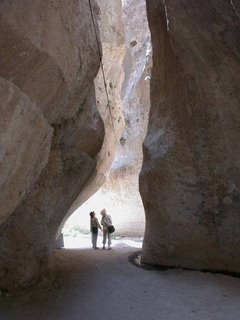
13 August 2006
When at Mar Musa, a must-do day trip is the combo Saidnaya and Ma’aloula outing. These are two important Christian sites in Syria, and seeing as we’re busy working on an important Christian monastery, we thought we’d go visit some more. Saidnaya is a pilgrimage site that has continued to be visited by both Christians and Muslims since ancient times. During the medieval period, it was the second most popular pilgrimage site in the Middle East after Jerusalem. This is because it contains an icon of Mary purportedly painted by Saint Luke who would have actually known what she looked like. It sits in a tiny semi-circular chapel about 3 metres by 3 metres. A nun wrapped from head to toe in black chants prayers by the holy oil standing in front of the icon where people kneel and pray one at a time. The icon itself is obscured by the gifts of necklaces or other trinkets including amulets of body parts that need healing. Despite the fact that you can’t actually see the icon, the air is thick with a powerful sense of spirituality and history. We all left with our very own cotton balls soaked in holy oil, and white strings around our wrists marking our vows of devotion to Mary. We felt very holy.
Around Saidnaya, we also stopped by the Cherubim Monastery which was built in a building originally used as a Roman temple. Big stone blocks. Very impressive. Saint Thomas monastery nearby was also built in a former Roman temple and really looked it…HUGE stone blocks….bigger than me! The temple is almost entirely unchanged except for the added medieval front door and the nave jutting out of the side of the building. Nice caves around there too…some of which were used for making oil and wine.
Ma’aloula came next. It is the only remaining Christian town where they still speak Aramaic (aka the language of Christ). The other two towns are Muslim. We visited the monastery of Sergius and Bacchus...the longest continuously occupied church of a single cult in the world….it’s 1700 years old! Our very knowledgeable guide recited the Lord’s Prayer in Aramaic for us which was very nice. Francesca was incredibly excited to see the altar from before the Council of Nicea (it’s got a semi-circular shape rather than the rectangle used now). Personally, I was impressed by their ability to reclaim a 300 year old icon that was stolen and returned thanks to good documentation (museum geek…that’s me).
Next we walked through Thekla’s gap…a crevice in the rock through which Saint Thekla is said to have escaped Roman soldiers who were ordered to kill her for her Christian faith. We followed it to the monastery built around the cave where she spent the next 75 years of her life and where she is now buried (in a room where a nun wrapped from head to toe in black chants prayers by the holy oil). After a nice rest under the tree in Thekla’s cave, we returned to the van and our trusty driver Abu Adib, and returned to our very own monastery, just in time for prayers.
Overall, a lovely mini-pilgrimage and we all felt shiny and holy.
Jovanna
Thursday, August 17, 2006
Museum trip

Most of our excursions start with breakfast at a little bakery in al-Nabk, the town near the monastery. Here the team are enjoying "little boat-shaped cheesy pizza things" (I really need to find out the Arabic term for those things). Our objective on this day was actually work, we were to visit a newly opened museum at the nearby town of Deir Atiyeh, to see how it would compare with the museum we intend to build for the monastery. It is a very large complex of buildings, architecturally influenced by the work at Deir Mar Musa, using traditional techniques of building with stone, so it would be a close parallel to our own building. It was a fascinating exhibit inside, but they seemed to have gone into the "open storage" type of exhibit, essentially indiscriminatly putting out everything they have. My favourite was the dsiplay of plough-shares, which looked like someone had alarmed a flock of starlings!

It was a long hard day, and after a while museum fatigue completely overwhelmed us. We totally lost the ability to discern what was worth looking at, and what wasn't. Here the team are mesmerised by a display of gun cartridges in the military exhibit.

On the whole it was very informative, and gave us some ideas for the Deir Mar Musa exhibition building.
Robert
Snake Cave
Most of the caves we are going to be looking into are in areas that can be scrambled up to. There are some that will need ropes, but for that I will need to wait for Tiago to arrive. Until then I will continue to scramble into the caves in the valley.
Yesterday we found two really great caves. One had three little tunnels and some interesting looking nooks. The next was a really long and dark cave. The tunnels looked like they went far into the mountain. As I started into one of them I noticed a dark, shiny coil of scales. I don't like snakes. I never used to be scared of snakes, but after living in Africa for a year I am no longer even able to stand Canadian snakes of the garden variety. I was out of that cave pretty fast. Still, it was a very interesting looking cave, so if someone else wants to see if the Arc of the Covenant is inside, they are welcome.
I am really looking forward to getting into more caves. I hope we find some more really deep ones….preferably deep caves with nothing scaly inside.
Francesca
Yesterday we found two really great caves. One had three little tunnels and some interesting looking nooks. The next was a really long and dark cave. The tunnels looked like they went far into the mountain. As I started into one of them I noticed a dark, shiny coil of scales. I don't like snakes. I never used to be scared of snakes, but after living in Africa for a year I am no longer even able to stand Canadian snakes of the garden variety. I was out of that cave pretty fast. Still, it was a very interesting looking cave, so if someone else wants to see if the Arc of the Covenant is inside, they are welcome.
I am really looking forward to getting into more caves. I hope we find some more really deep ones….preferably deep caves with nothing scaly inside.
Francesca
Wednesday, August 16, 2006
Communications
If any of the team's contacts are out there wondering why we have time to post blogs but never write them e-mails, I'm afraid our internet access is very limited, and some e-mail accounts do not work at all, while others work only occasionally. Any sort of internet use is problemtaic. One member of the team wanted to apply for a very promising job, but the application was on-line, and it would have probably taken about two days in front of the computer to fill it in and upload the appropriate attachments - and as there is only one line that would be very inconvenient for the monastery! I think next year I shall try to acquire a satellite telephone!!
Robert
Robert
Tuesday, August 15, 2006
Church frescos
One of the remarkable things at the monastery is the cycle of mural paintings. This year I made sure I had every single painting photographed. Here is a selection. They comprise a sequence of successive layers, the latest is dated to 1209 AD.
 |
| This is the glorious Eastern wall, with the Last Judgement. |
 |
| This angel with a towel is standing ready to dry Jesus, who is being baptised by John on the Western wall of the church (to the left, now mostly lost). |
Saturday, August 12, 2006
One week down!!
So! We have now been here a full week, having arrived a week ago last night. Work has continued steadily. Francesca and I have located 8 interesting caves which look like they may have been homes for hermits in the past. For each we have created a rough scale plan, and collected a GPS point as reference. We have also found and located by GPS a lime kiln, a cistern with a weir, and another structure which was either a cistern, a building, or an agricultural terrace. All of these would be worth excavating in future seasons.
Jovanna and Francesca have been working very hard at cleaning pottery found during earlier seasons in work on the buildings or the more adjacent caves; and this has been partly processed by Joelle who is also working on the database of objects for the future museum. Jovanna and Francesca have also been on plant-hunting expeditions to collect for the herbarium we are developing for the museum.
Today we had a day off and went to a whole string of other monasteries! One to the Cherubim (our driver’s idea); one to St. Thomas; another to Our Lady (Saidnaya); and the two monasteries at Ma’aloula. I think one of the others will be posting on the experience.
Robert
Jovanna and Francesca have been working very hard at cleaning pottery found during earlier seasons in work on the buildings or the more adjacent caves; and this has been partly processed by Joelle who is also working on the database of objects for the future museum. Jovanna and Francesca have also been on plant-hunting expeditions to collect for the herbarium we are developing for the museum.
 |
| A plant being pressed. Typically Jovanna collects one, or half of one, for the ROM and one for the monastery herbarium. |
Today we had a day off and went to a whole string of other monasteries! One to the Cherubim (our driver’s idea); one to St. Thomas; another to Our Lady (Saidnaya); and the two monasteries at Ma’aloula. I think one of the others will be posting on the experience.
Robert
Wednesday, August 09, 2006
Winding Stairways and Tiny Doorways

Without further delay- here’s my first ever blog entry!
I’ve been reluctantly thinking of things to write in this blog. Having never written one before, I wasn’t really sure where to start. This is my first time in Syria, I’ve been staring and gawking at images of Mar Musa for months now. Five days after arrival, I’m still taking in the landscape (I’ve been getting over a sniffle, so there’s not much else to do but stare out the windows while I work on the images database). This place is truly and completely breathtaking with scenery taken straight from storybooks. We’re living in castles, built into the mountains. Beautiful open spaces, some very narrow spaces, chipped away from the cliff faces, built up with stone masonry, joined by the tiniest of doorways and some of the most intricate stairways I’ve ever seen. It’s a 1.5-ish km hike up a winding stairway to get to the entrance of the old monastary (a doorway that can’t be more than three feet high). To get to our rooms, located in the neighbouring Hayek building (cave of the weaver), it’s another 20 minute hike (This can be quite the workout for Francesca who keeps forgetting the key)! Jovanna considered taking a real-time video of how long it takes for us to get from point a. to point b. I think we should post it on this blog, for emphasis.
That’s it for now, next time I think I’ll post a list of Arabic words I should use most often--- since I need to be better at using them……often… every day.
Joelle
Tuesday, August 08, 2006
Palmyra
 |
| Joelle and I enjoying the shade. |
Having arrived, unpacked an d got our bearings, we thought we'd recover from the journey by taking a trip to Palmyra! Sleeping in the bus for a couple of hours was probably a good idea, and we needed cheering up after the exhausting journey. It was an excellent day in these remarkable ruins, which always make me think of the futility of life, and the fundamental absurdity of existence. My idea of fun! After seeing the ruins, the tombs, the museum, and having a lovely time drinking tea in one of the shops, and lunch of Bedouin cuisine in one of my favourite Syrian restaurants, we watched the sunset from the medeival castle overlooking the site.
 |
| Francesca enjoying the sunset. |
After sleeping in the bus on the way back to Deir Mar Musa, we awoke the next day invigorated and ready to get on with some work!
Robert
Monday, August 07, 2006
Budding Botanists
Jovanna
Sunday, August 06, 2006
Travel Colours
When traveling, one of the things that usually strikes me about a country is its colour. France has a fresh yellow green, Ireland is a darker, lush dripping green, Italy has burnt umbers and gold and green, Cuba is turquoise, England has a slate grey, etc.. Syria is warm camel brown with soft shades of pink and purple. The sky is a blue you'll never see in Canada, with day after day of cloudless skies. And the light is an active participant in the landscape, changing the mountains and desert from blues to whites to soft browns to pinks to purples. All day long you are aware of the sun moving across the sky. You can tell the time by it. And of course the moon should not be forgotten, as it does the same thing moving from the mountain on one side of us to the other.
Before coming to Syria, I had no idea how bright the moon could really be. You really don't need a light with you when walking, and the shadows have a completely different depth to them than shadows made by the sun. When you grow up in a city where the sky is seen from between buildings, or even camping when the sky is seen from between trees, the desert moon is a surprising and unforgettable thing. I saw all this last year when I was here, and I loved it. But then I came back to Toronto and my eyes returned to their usual palette. Greys, multi-coloured shiny shops, rich blue greens, darker blue skies with clouds seen behind and above buildings. They forgot the palette of Syria until I got back to Mar Musa, and now the colours feel so familiar it's hard to believe they are colours that I've seen no where else. They are inseparable now from my memory of Syria, one more patch in my colourful travel quilt.
Jovanna
Before coming to Syria, I had no idea how bright the moon could really be. You really don't need a light with you when walking, and the shadows have a completely different depth to them than shadows made by the sun. When you grow up in a city where the sky is seen from between buildings, or even camping when the sky is seen from between trees, the desert moon is a surprising and unforgettable thing. I saw all this last year when I was here, and I loved it. But then I came back to Toronto and my eyes returned to their usual palette. Greys, multi-coloured shiny shops, rich blue greens, darker blue skies with clouds seen behind and above buildings. They forgot the palette of Syria until I got back to Mar Musa, and now the colours feel so familiar it's hard to believe they are colours that I've seen no where else. They are inseparable now from my memory of Syria, one more patch in my colourful travel quilt.
Jovanna
Saturday, August 05, 2006
Moonlight Walk
One of the objectives of this year’s fieldwork is to identify those caves used by monks as hermitages in the medieval period, especially those that might be fruitfully excavated in future years. Although it isn’t necessary to identify them all this year, it would be good to identify all of the ones that we need special climbing expertise to examine, as this is the year we have the climbing team of Francesca and Tiago to do this. Tiago will join us in a few days, so Francesca is keen to identify all the possible hermit’s caves that will need her climbing expertise before Tiago arrives, so on Sunday we went looking for some that had been brought to our attention by Brother Jens, one of the monks of the monastery. He said it was just in the next valley, and we should easily get to it after a 4:00 pm start, and return by the beginning of the evenings services at 7:30. So we set off in pursuit of distant potential hermitages.
 |
| Br. Jens (left) and me. |
 |
| Francesca looking across the Syrian desert |
We found three caves worth excavating not far from the monastery, but did not record them properly as this was a reconnoiter expedition, and the objective was to get to “the next valley”. We eventually did get to this valley, and were rewarded by some truly stunning topography, rather reminiscent of the Grand Canyon on a smaller scale. It was certainly an area of outstanding natural beauty, and well worth the trip, but there were really not that many caves except some that still seem to be regularly occupied by goatherds. However, what started to be of some concern is that we were still some distance away from the monastery, and the sun was going down. I had a vague idea where we were, and knew it was still pretty far. It was pretty evident that Jens had greatly underestimated the distance and the time it would take us. We have cause to give thanks, however, as the sun did not go down until we were out of the mountains, and there was a moon that was almost full. However it still took us a further hour or so of walking over the stony plain below the mountain, entirely by moonlight, to get back to the monastery, over 5 hours after we had left. We all had torches (flashlights?), and so were never in any danger, but the moon was powerful enough that we could see quite clearly by that. I think Jens was feeling rather contrite, and I was rather worried about my foot, which I had broken two months before (I had been out of the cast for just over two weeks), but for Francesca it was just a fun hike.
Robert
We're here!!

The team has safely arrived at Deir Mar Musa, getting in at about 9:00 pm last night. Everyone is very excited, although very tired. Today we set up our working area, and unpacked. Joelle and I will now try to work out the differential GPS, and then we will go for a walk!
Talking to the locals, there never really has been much to worry about in coming to Syria, and we are looking forward to an uneventful season. Francesca has looked at the climbing, and has pronounced it "easy". My concern was in having inexperienced people on the rocks, but for Tiago and Francesca it will, apparently, be a morning stroll (not an afternoon stroll, it's too hot here in the afternoon!).
The pic is of Francesca and Joelle unpacking in the library reading room, which will be our base of operations for the season.
Look forward to more postings!
Robert Mason
Tuesday, August 01, 2006
Green Light
Despite the troubles in the Lebanon, the expedition is scheduled to go ahead. We will be leaving Toronto on the 3rd August, and arriving in Damascus the next day. By the end of the day, we will be at the monastery - inshallah! Research at Deir Mar Musa in the 2006 season is aimed at a number of objectives, but the primary one is a survey of the caves and other features in the desert mountain behind the monastery. Deir Mar Musa is what is known as a "Laura", a community in which the monks lived in hermitages spread around the landscape, and only came into the main monastery buildings on Sunday to pray together, and collect materials they needed for the rest of the week. At Mar Musa, they actually lived in small caves spread around the landscape. Our objective in this season is to survey these caves, to see how many there were, and how many were occupied. The team will comprise myself; Joelle Chartrand, who is the other archaeologist on the team this year; Francesca Scorsone and Tiago Varella-Cid, who are climbers I will need to have explore some of the more inaccessible caves in the study area; and Jovanna Scorsone, project museologist, who will work on preparing materials from previous seasons for the proposed museum.
Robert Mason
Robert Mason
Subscribe to:
Comments (Atom)
